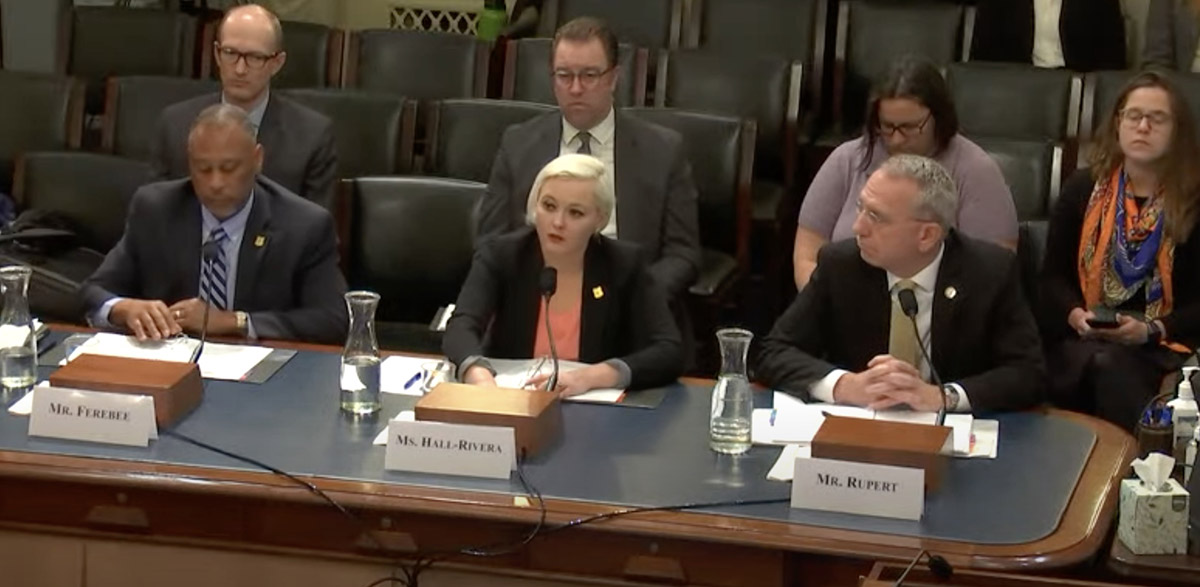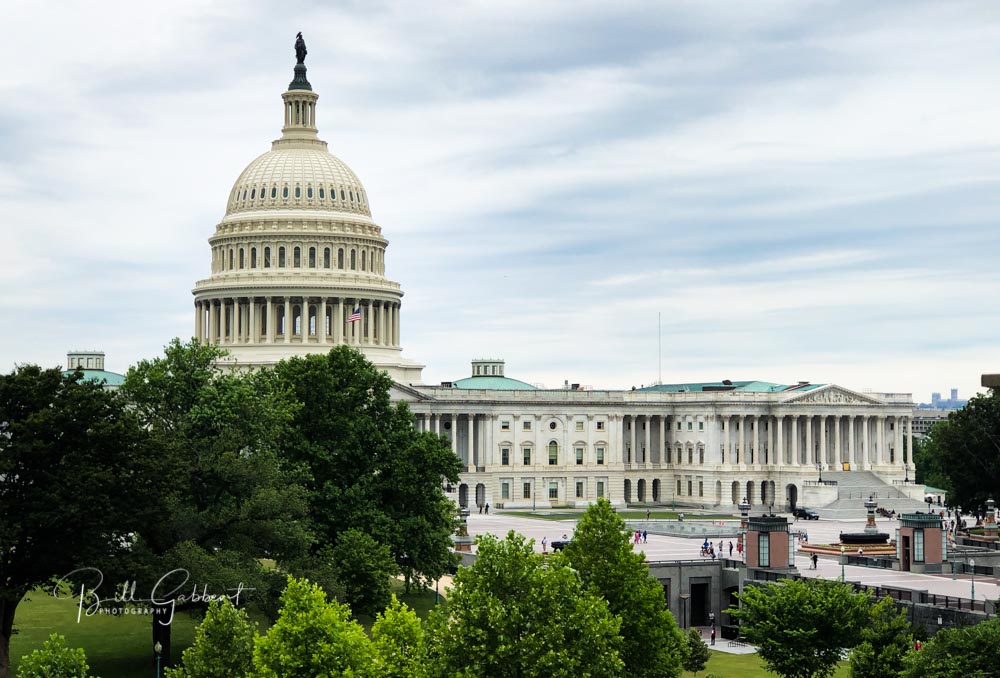
The standard line from the US Forest Service about the number of wildland firefighters in the agency has been 10,000 wildland firefighters nationwide, but in recent years they have been unable to fill all of their positions due to difficulties in recruitment and retention. The San Francisco Chronicle (subscription) reported that in 2021 the number stationed in California dropped from 5,000 in 2019 to 3,956, more than a 20 percent decline.
In a hearing today before the House Subcommittee on National Parks, Forests, and Public Lands, the Forest Service said they believe they are turning that problem around.
Representative Katie Porter from California asked how many firefighters does the agency need to have. Jaelith Hall-Rivera, USFS Deputy Chief of State and Private Forestry said their goal this year is 11,300. That would be 13 percent more than the maximum they have had in recent memory.
When Rep. Porter asked how many they have now, Ms. Hall-Rivera said she didn’t know because they are still hiring.
“We just completed an additional fire hire event in California at the end of March and those numbers are still coming in,” Ms. Hall-Rivera said. “I do think we are on pace [to meet that goal]. By all accounts that hiring event went very well. Importantly what we are seeing is a very high acceptance rate in our permanent and seasonal permanent firefighting positions, which is what we want. We want to be able to convert this workforce to have more or a larger proportion of it to be permanent and a smaller proportion of it be temporary… We think that we will be at the capacity we need at the Forest Service this year.”
“That’s really great to hear,” Rep. Porter said, “because as you know last year according to the National Federation of Federal Employees, about 30 percent of the federal hotshot crews that worked on the front lines of wildfires in California were understaffed. Last year the Forest Service had 60 fire engines in California alone that were idled because of understaffing. I’m very heartened to hear a concrete number, a concrete goal, for what full staffing looks like.”
Rep. Porter asked how much it costs to bring in firefighters from other fire departments when the Forest Service does not have adequate staffing for fire suppression. Ms. Hall-Rivera said she did not have those numbers, but would get back to the Representative. Firefighters from CAL FIRE and municipal fire departments make two to three times what federal wildland firefighters make and they get paid 24 hours a day, “portal to portal”, for weeks on large fires until they are back in their own station. Federal firefighters are usually limited to 16 hours a day, and are forced to take a 30 minute lunch break even when they are on the steep slope of a God-forsaken ridge breathing smoke miles from the nearest road.
Earlier Ms. Hall-Rivera said the Forest Service has lost 40 percent of their non-fire workforce. This reduction in personnel, some of whom were qualified to be assigned to a fire in addition to their regular duties, can increase the difficulty of staffing fires and other incidents.
Wildland Fire Mitigation and Management Commission
Rep. Yvette Herrell of New Mexico asked when members would be appointed to the new Wildland Fire Mitigation and Management Commission, which was required by the Bipartisan Infrastructure Law, H.R.3684, signed by the President on November 15, 2021. The law required that the appointments were to be made by January 14, 2022. Their initial meeting was to be held no later than February 13, 2022.
Ms. Hall-Rivera said the announcement for applications closed last Friday after receiving more than 500 responses. The members will be selected “in a month or two,” she said.
Tamarack Fire and aggressive initial attack
Representative Tom McClintock of California, brought up the subject of the Tamarack Fire in California which was monitored but not suppressed for 13 days while it was very small. It burned at least 15 structures and more than 67,000 acres as it ran from California into Nevada jumping Highway 395 and prompting the evacuation of 2,000 people.
“This is insane,” Rep. McCLintock said, referring to the management of the fire. “Please tell me that you are dropping that policy and you will be vigorously attacking fires on their initial discovery rather than waiting for them to become one of these massive conflagrations.”
“We put out 98 percent of fires on initial attack,” Ms. Hall-Rivera said. “The Tamarack Fire is one of those 2 percent that we were not able to do that because we were resource-limited in the country as a whole.”
“You deliberately sat on it,” Rep. McClintock said. “Can you assure me that henceforth upon discovery of a fire you will order an aggressive initial attack?”
“Yes, Congressman, that is what we do,” said Hall-Rivera.
Goals for fuel treatment
“While the Forest Service’s budget has more than doubled since 2014, the amount of hazardous fuels treatment has remained frustratingly stagnant, only addressing roughly two percent of their needs annually,” said Rep. Herrell. “I am concerned that the recently announced 10-year strategy to combat the wildfire crisis will fall short because not only are the tools not in place to implement this strategy, but the Forest Service is also only relying on only 5 years of funding to execute a 10-year plan. This is especially concerning considering yesterday’s release of the Department of the Interior’s wildfire strategy which is only 5 years.”
“The Infrastructure law was a significant step in the right direction in terms of wildland firefighter compensation, and once again I thank you for your work on that,” Ms. Hall-Rivera replied. “But we need to continue to work together to find a permanent solution to increasing our wildland firefighters’ pay and making other system changes that insure that we can continue to support our firefighters and insure that this is a career that others will pursue in the future.”
Rep. Herrell asked why the 10-year strategy included no references to how it will be implemented. Ms. Hall-Rivera said that it was a timing issue, in that the strategy was being prepared while the legislation was being considered.
Staffing for the additional fuel management workload
Rep. Ruben Gallego of Arizona asked in regards to the additional funding and new initiatives outlined in the Infrastructure legislation, “Does the Forest Service have adequate staff capacity to fill the new dollars they will be responsible with implementing, and how does the Forest Service intend to address staffing capacities with new hiring?”
After Ms. Hall-Rivera and Brian Ferebee, Chief Executive of Intergovernmental Relations for the Forest Service, glanced at each other, Mr. Ferebee turned on his microphone and basically said they were looking at the issue.
My take:
I did not summarize every topic that came up in the hearing, but attempted to capture the most significant ones related to wildland fire. After reading through the above, I noticed a trend: PLANNING, and a lack thereof.
- Failure to meet the deadlines required for the establishing the Wildland Fire Mitigation and Management Commission.
- Planning to rely on only 5 years of funding to execute a 10-year plan for fuel management.
- The 10-year strategy included no references to how it will be implemented. “The strategy was being prepared while the legislation was being considered.”
- The Forest Service does not know if they have enough staffing to accomplish the new initiatives outlined in the Infrastructure legislation.
It reminds me of the effort by Congress to transfer seven C-130 aircraft to the Forest Service to be converted to air tankers.
On December 27, 2013, President Obama signed the 2014 National Defense Authorization Act which directed the Coast Guard to transfer seven HC-130H aircraft to the U.S. Forest Service. The legislation also supplied $130 million for the Air Force to perform needed maintenance on the aircraft and to convert them into air tankers.
About 522 days later, on June 1, 2015 the FS distributed internally a “Briefing Paper” that revealed the agency was not prepared to manage a long term safety oversight program for this government owned/contractor operated venture (GO/CO). On that date the the FS had no detailed operating plan and had not hired or appointed any long-term, full-time safety personnel. The document also stated that “the military model for a squadron of seven HC-130H aircraft is to have TWO [sic] full time safety officers assigned.”
“The time frame to create one or more new positions to provide aviation safety oversight duties”, the Briefing Paper said, “would likely be lengthy and not meet Agency HC-130H requirements in time for the 2015 fire season.”
The FS did not use the 522 days to plan for the absorption of the aircraft into the fleet.
They came to a conclusion, according to the Briefing Paper:
This is a new program for the Forest Service, one that we have never managed before (We don’t know what we don’t know).
Eventually, more than four years after the transfer and tens of millions had likely been spent on the refurbishment of the seven aircraft, the Forest Service decided they did not want the air tankers. Congress passed additional legislation to give the seven HC-130Hs to the state of California instead.
Video of the hearing:



